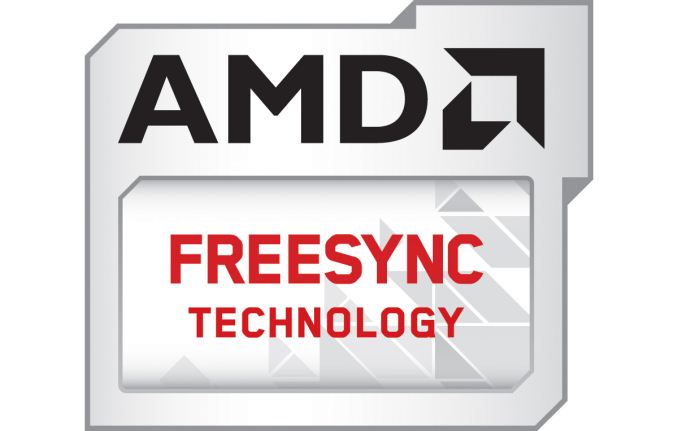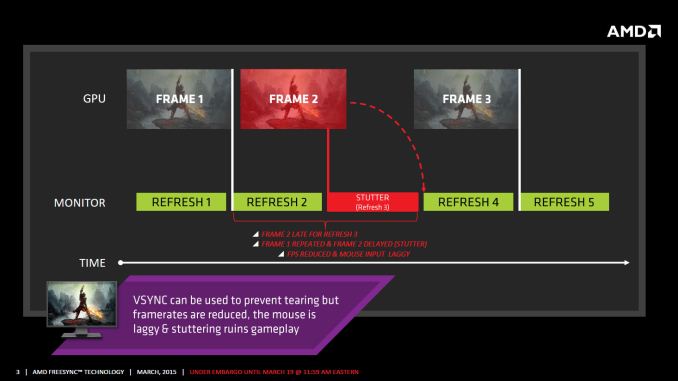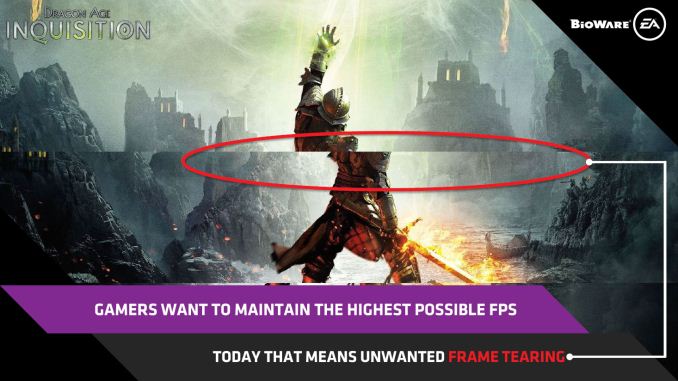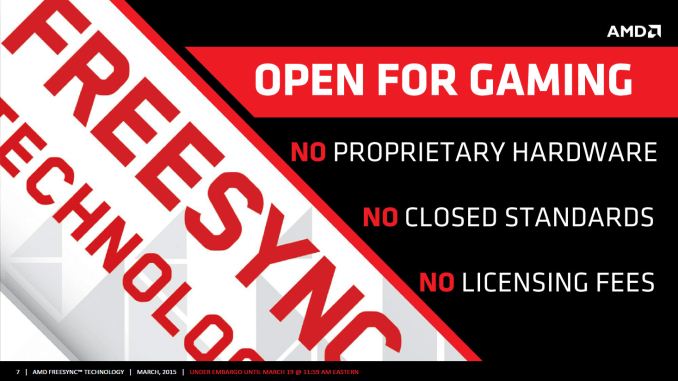The AMD FreeSync Review
by Jarred Walton on March 19, 2015 12:00 PM EST
Introduction to FreeSync and Adaptive Sync
The first time anyone talked about adaptive refresh rates for monitors – specifically applying the technique to gaming – was when NVIDIA demoed G-SYNC back in October 2013. The idea seemed so logical that I had to wonder why no one had tried to do it before. Certainly there are hurdles to overcome, e.g. what to do when the frame rate is too low, or too high; getting a panel that can handle adaptive refresh rates; supporting the feature in the graphics drivers. Still, it was an idea that made a lot of sense.
The impetus behind adaptive refresh is to overcome visual artifacts and stutter cause by the normal way of updating the screen. Briefly, the display is updated with new content from the graphics card at set intervals, typically 60 times per second. While that’s fine for normal applications, when it comes to games there are often cases where a new frame isn’t ready in time, causing a stall or stutter in rendering. Alternatively, the screen can be updated as soon as a new frame is ready, but that often results in tearing – where one part of the screen has the previous frame on top and the bottom part has the next frame (or frames in some cases).
Neither input lag/stutter nor image tearing are desirable, so NVIDIA set about creating a solution: G-SYNC. Perhaps the most difficult aspect for NVIDIA wasn’t creating the core technology but rather getting display partners to create and sell what would ultimately be a niche product – G-SYNC requires an NVIDIA GPU, so that rules out a large chunk of the market. Not surprisingly, the result was that G-SYNC took a bit of time to reach the market as a mature solution, with the first displays that supported the feature requiring modification by the end user.
Over the past year we’ve seen more G-SYNC displays ship that no longer require user modification, which is great, but pricing of the displays so far has been quite high. At present the least expensive G-SYNC displays are 1080p144 models that start at $450; similar displays without G-SYNC cost about $200 less. Higher spec displays like the 1440p144 ASUS ROG Swift cost $759 compared to other WQHD displays (albeit not 120/144Hz capable) that start at less than $400. And finally, 4Kp60 displays without G-SYNC cost $400-$500 whereas the 4Kp60 Acer XB280HK will set you back $750.
When AMD demonstrated their alternative adaptive refresh rate technology and cleverly called it FreeSync, it was a clear jab at the added cost of G-SYNC displays. As with G-SYNC, it has taken some time from the initial announcement to actual shipping hardware, but AMD has worked with the VESA group to implement FreeSync as an open standard that’s now part of DisplayPort 1.2a, and they aren’t getting any royalties from the technology. That’s the “Free” part of FreeSync, and while it doesn’t necessarily guarantee that FreeSync enabled displays will cost the same as non-FreeSync displays, the initial pricing looks quite promising.
There may be some additional costs associated with making a FreeSync display, though mostly these costs come in the way of using higher quality components. The major scaler companies – Realtek, Novatek, and MStar – have all built FreeSync (DisplayPort Adaptive Sync) into their latest products, and since most displays require a scaler anyway there’s no significant price increase. But if you compare a FreeSync 1440p144 display to a “normal” 1440p60 display of similar quality, the support for higher refresh rates inherently increases the price. So let’s look at what’s officially announced right now before we continue.













350 Comments
View All Comments
Refuge - Friday, March 20, 2015 - link
Thats the thing, this is clearly a tech that can help lower end GPU's provide a better gaming experience, and it is a patch away for nVidia.Them saying they won't or them just not doing it is honestly a slap in the face to every customer of theirs. Me included, I don't want my GPU to work better with one monitor than another because of a branding issue.
if nVidia doesn't support Freesync, I'll just never buy their products again. I honestly don't see why they wouldn't support it. Then their GPU's work with everything and AMD are still stuck to Freesync.
Not only is it insulting to me as a customer, it is also stupid from a business standpoint as well.
Creig - Friday, March 20, 2015 - link
AdaptiveSync - An open VESA industry standard available for free to any company that wishes to utilize it.G-sync - Nvidia's proprietary solution that they collect royalties on and refuse to allow any other company to use.
Big difference.
tobi1449 - Friday, March 20, 2015 - link
Plus I doubt the companies producing the scalers don't want their cut for additional features like this one.cbutters - Friday, March 20, 2015 - link
So you are arguing that the cost is that you have to stick with AMD hardware? For one, how is this a cost?? But my point is the only reason that you would have to stick with AMD hardware is because NVIDIA chooses not to support displayport 1.2a. So it is NVIDIA costing you.Secondly, You are not limited to AMD hardware, rather NVIDIA is excluding itself from your next purchase. Freesync is not closed tech... Intel graphics chips could adopt it tomorrow since it is an open standard. It is NVIDIA that is closing down options, not AMD.
JonnyDough - Monday, March 23, 2015 - link
Costs will trickle down somehow...yes with good PR. AMD spent a ton developing this only to give it away for free. It will pay because it makes NVidia look bad. I'm not a fanboy, I prefer NVidia's drivers usually. I just like AMD better because they compete on cost, not match it like an oligopoly.anubis44 - Tuesday, March 24, 2015 - link
"Costs still trickle down somehow..and that cost is you having to stick with AMD hardware when you buy a new monitor."That's not a cost AMD is imposing on us, it's a cost nVidia is imposing on us, by stubbornly refusing to give their customers Freesync compatible drivers. nVidia is simply trying to grab as much cash as possible, and people like you are helping them rip us all off.
chizow - Tuesday, March 24, 2015 - link
How is it not a cost AMD is imposing? LOL. FreeSync panels carry a premium over non-FreeSync panels, this is a fact. AMD has said it is the panel mfgs charging a premium for higher quality components, specifications, engineering/QA costs. No one has a problem with this, even AMD fanboys like you.Yet when Nvidia does the same, especially when their G-Sync module is clearly doing a better job at what it needs to do relative to the new FreeSync scalers, all while offering more features (3D and ULMB), suddenly there's a problem and Nvidia has no right?
LOL, idiots. Nvidia and their mfg partners are charging more because the market sees value in their superior products, simple as that. These are the same mfgs btw, if they thought they could charge more they would, but clearly, they also see the Nvidia solution commands the higher price tag.
medi03 - Wednesday, March 25, 2015 - link
BS.As mentioned in the article, FreeSync support is no big deal and is already supported by most upscaler chips out there. Had there been "hidden cost" they wouldn't do it.
FriendlyUser - Thursday, March 19, 2015 - link
How is it better because it works with Nvidia hardware? I mean, if you have a Nvidia card you don't have a choice. That doesn't make GSync better in any meaningful way.dragonsqrrl - Thursday, March 19, 2015 - link
... If you currently have an AMD card, you have much less of a choice. Actually given the restriction of GCN 1.1 or later, there's a decent possibility you have no choice.